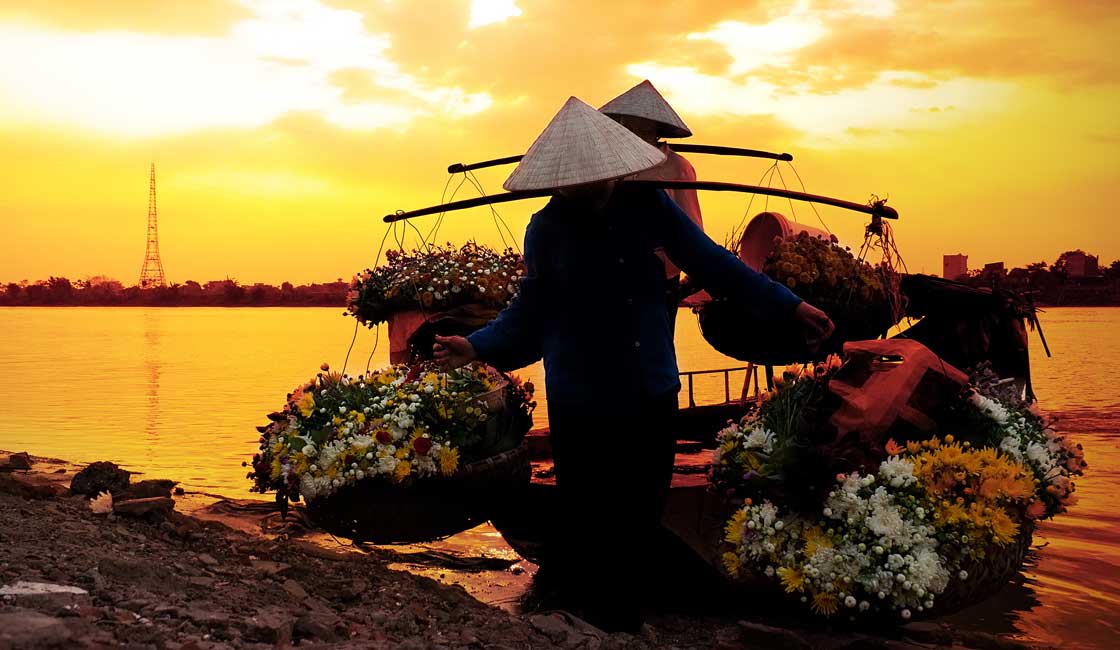
The choice of Vietnam tourist attractions is staggering; this mesmerizing country blessed with jaw-dropping natural beauty, an unfair tally of World Heritage Sites, historical legacies extending from 10th-century pagodas to wartime tunnels, vibrant cities revealing multi-national architectural wonders, and rich cultural diversity. One trip may not be enough, but for first-timers, be it, honeymooners or adventure seekers, here’s our what to see on your trip to Vietnam.
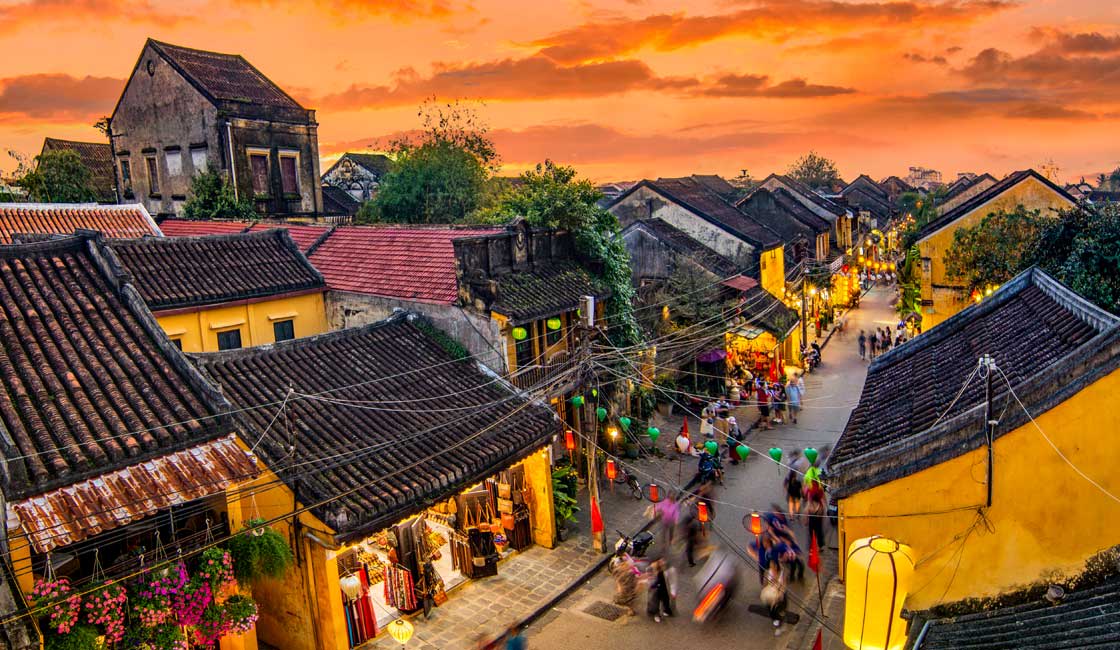
The beauty of Hoi An Old Town is well renowned
Hoi An’s utterly charming Ancient Town is one of Vietnam’s top attractions, but despite the crowds, still hasn’t lost its beguiling charm. Centrally located in Hoi An town, alongside picturesque Thu Bon River, this compact enclave was once a thriving Silk Road trading port, from the 16th to 19th centuries. Today, this beautifully preserved Ancient Town is one of Southeast Asia’s oldest towns and a designated UNESCO World Heritage Site, its atmospheric narrow streets lined with centuries-old cultural treasures, historic sites, and quaint buildings, a hybrid of the port’s multi-national architectural legacies.
Admire the Chinese shophouses and gaudy assembly halls, iconic Japanese Covered Bridge, and faded French colonial-era mansions. This old quarter is also home to a strong local community, with markets and artisan workshops and riverside open-air cafés and restaurants, perfect for sampling local culinary delights. The Ancient Town comes into its own after dark, especially during the monthly, full moon lantern festival, when, traffic-free streets are illuminated solely with hundreds of multi-colored silk lanterns and vibrant with traditional festivities.
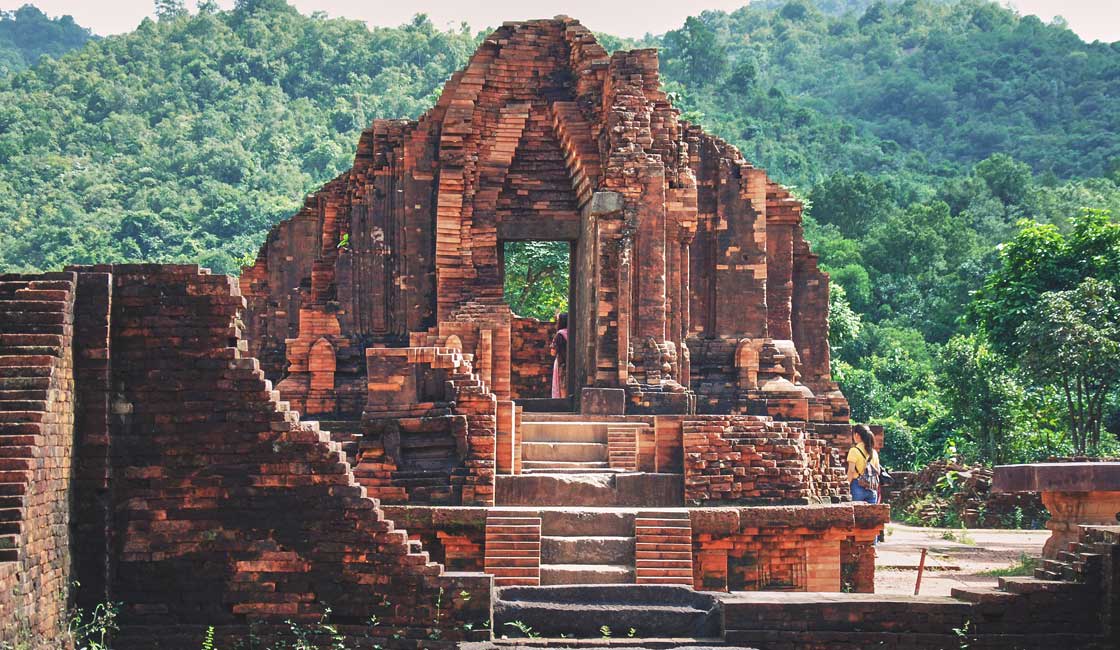
The old kingdom in ruins
While in Hoi An, be sure to visit My Son Cham towers, located southwest. Not only is this one of Vietnam’s most striking examples of its ancient Champa Kingdom and a World Heritage Site, but also one of Southeast Asia’s most important archaeological sites and a foremost Hindu temple complex. Set in a narrow wooded valley, surrounded by forested mountains, this evocative Cham temple sanctuary was once an important spiritual and political center and royal burial ground of the former Champa civilization, built between the 4th to the 14th centuries.
My Son lay neglected for centuries, rediscovered by French archaeologists in 1898. Ravaged by time, ironically the greatest damage occurred during the Vietnam War, however, the majority of the central complex managed to survive the bombs and some parts are being restored. Devoted to Hindu Gods, the sanctuary is comprised of more than 70 red brick and sandstone temples arranged in clusters, incorporating striking decorative carvings, stele, sculptures, and inscriptions.
Today, in various states of ruin, repair, and vegetation overgrowth, My Son nevertheless is still impressive, with around 20 temple structures still standing. There’s also an interesting on-site museum; visit early morning to escape the tour groups and heat.
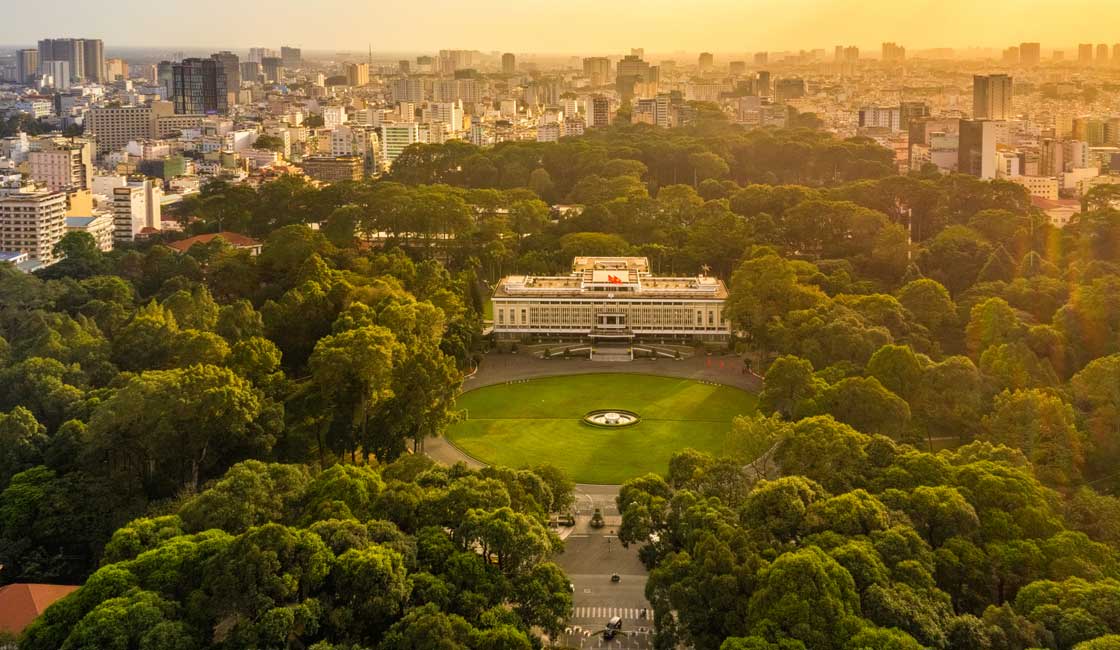
Palace in the noisy city center
Wartime legacies are prominent attractions in Ho Chi Minh City and these two museums are the most popular, equally fascinating, and a must-do experience. The imposing Independence Palace (or Reunification Palace) is of great symbolic importance in the nation’s history. Formerly, the South Vietnam government’s HQ and official presidential residence, this was where North Vietnamese Army tanks crashed through the main gates on April 30, 1975: the defining ‘Fall of Saigon’ moment and the start of Reunification.
Now a ‘National Cultural and Historical Relic,’ museum and VIP function space, this landmark monolith building, ensconced in pretty grounds, stands frozen in time from that fateful day. Take a guided tour through five floors and rooms preserved in the 1960s and 1970s time-warp: highlights include the bomb-proof basement, with secret tunnels and war command room, kitschy cinema and casino, and glittering reception halls.
Although somber and gut-wrenching, the War Remnants Museum is the city’s most-visited museum, where a series of exhibition rooms starkly chronicles the horrors and futility of war – (both the Vietnam and Indochina wars). Shocking exhibits contain graphic photojournalism, notorious ‘tiger cages’ and legacies of chemical defoliants, while the outer courtyard is littered with wartime fighter planes, tanks, and bomb varieties.
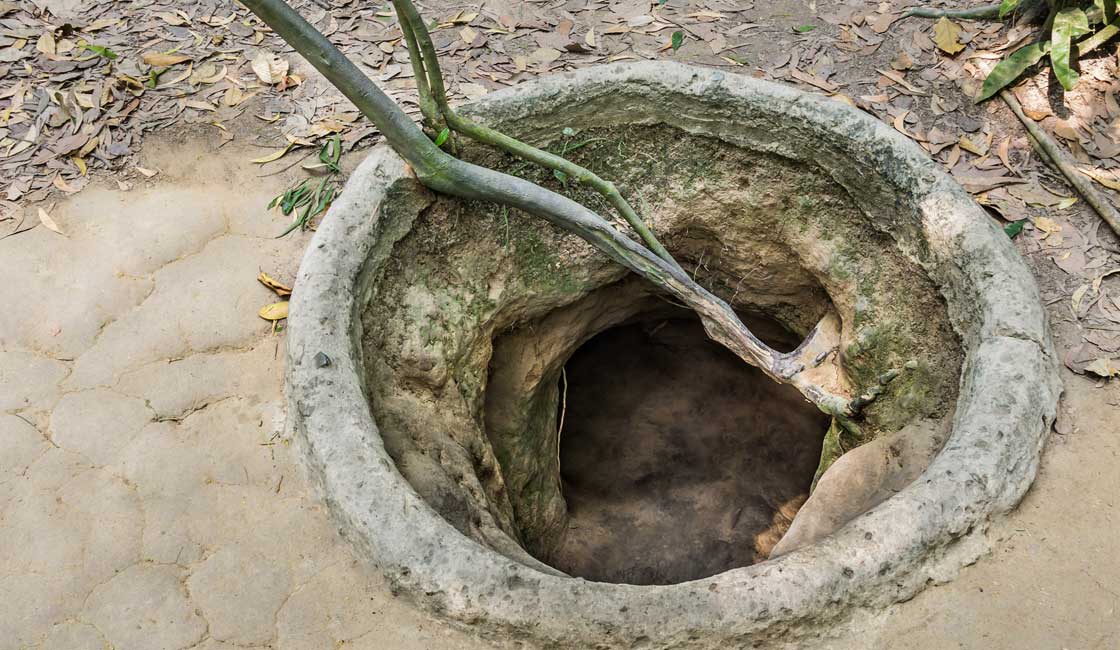
An entrance to the tunnel
Located north of Greater Ho Chi Minh City, the Cu Chi Tunnels provide a more interactive historical experience for all ages (although claustrophobics should perhaps miss this one).
Stretching for 100-plus miles towards former Saigon, this immense network of connecting underground tunnels was the secret HQ for the Viet Cong’s military operations during the Vietnam and Indochina wars. Of immense strategic value, the Cu Chi Tunnels played a major role in the Northern Vietnamese victory, regarded as one of their proudest wartime achievements.
These historic tunnels have now been preserved and transformed into a war memorial park and hugely popular attraction. Visitors can enter two short sections of the original tunnel network, at either Ben Dinh or Ben Duoc villages, which have been restored, slightly widened and cemented. Led by guides, crawl along the deep tunnels and get a rough idea of what conditions were like and see former subterranean facilities, like the conference rooms.
Above-ground attractions include a shooting range, display of mantraps and burnt-out tanks and a restaurant serving simple meals that the soldiers would have eaten. Some half-day tours offer speedboat transport along the river, for part of the journey here.
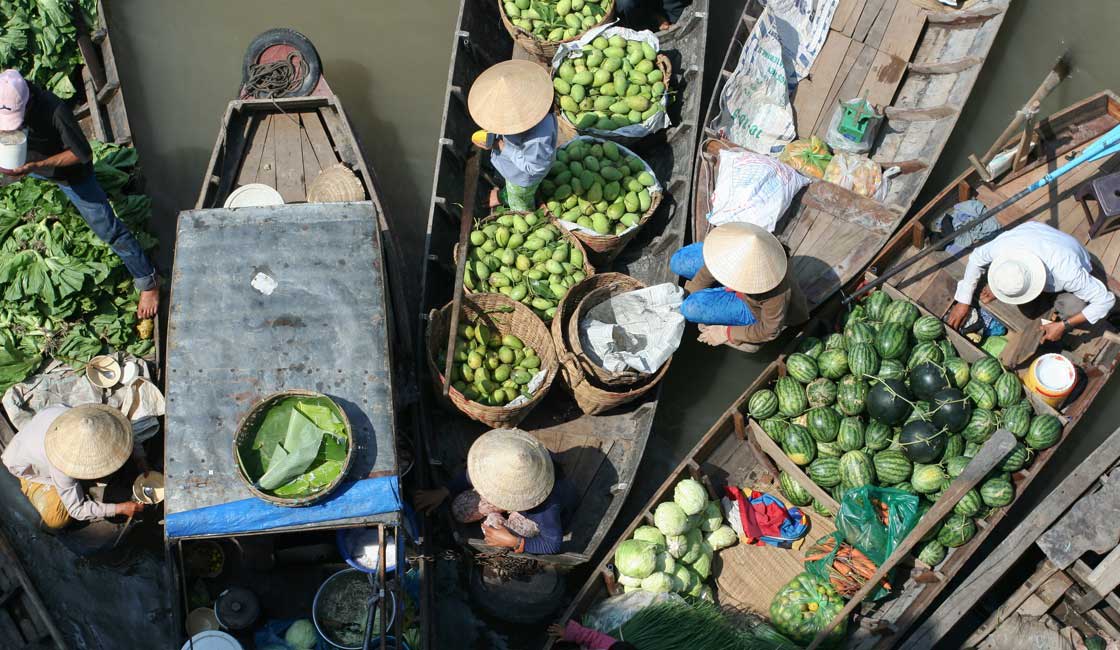
Vendors at work
The southern Mekong Delta is Vietnam’s most productive agricultural area, with an intensively cultivated bountiful landscape brimming with rice paddies, banana, sugarcane and coconut plantations, tropical fruit orchards and more. Visiting the Mekong Delta is one of the absolute musts when in Vietnam.
This lush, flat ‘Delta is also dominated by – and highly dependent on – the Mekong River, which branches out into a network of waterways and tributaries that for many is the main way of getting around. This may explain why this region’s traditional means of trading are floating markets, a way of life and trade for well over a century.
Despite modern-day developments, the ‘Delta’s floating markets are in decline, but many still operate in strategic localities; for visitors, this is an iconic Vietnamese sight and wonderful opportunity to engage with locals and experience a traditional southern culture – besides a fantastic photographic opportunity. Take an early morning guided tour on a small vessel, weaving in amongst dozens of colorful barges piled high with seasonal produce and household items and ordering Vietnamese breakfast and coffee from floating kitchens! The largest, most renowned floating markets are Phong Dien and Phung Hiep, but especially, Cai Be and Cai Rang, popular for its vibrant atmosphere. All can easily be visited in a day trip from Ho Chi Minh City, but afterward, continue boating deep into the ‘’Delta countryside, disembarking at fruit orchards and stilt-house communities.
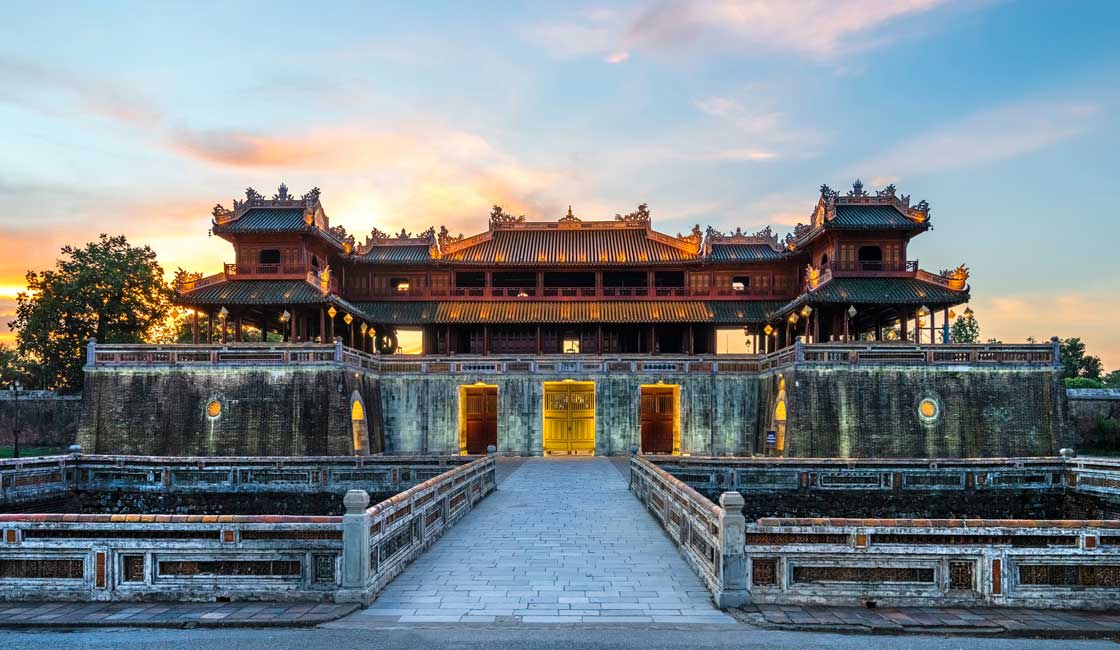
A forbidden city of Nguyen Dynasty
Located in the Central Provinces, Hue was Vietnam’s imperial capital from 1802 to 1945, the home of a dynasty of Nguyen Emperors and the nation’s political, cultural and religious heart. All those imperial legacies, a collection of relatively well-preserved ancient monuments, royal court traditions and relics of great historical and cultural importance, now come listed as a UNESCO World Cultural Heritage Site, or ‘Complex of Hue Monuments.’
Thus, this amiable, languid city, majestic beside the scenic Perfume River, offers visitors many attractions to see, many easily accessed by bicycle or on leisurely ‘Dragon Boat‘ cruises.
Hue’s crown jewel is the magnificent 19th century Imperial Citadel, a sprawling walled complex containing the Imperial Enclosure, Forbidden Purple City, palaces, temples, gates, and much more. Although much was destroyed during the Vietnam War, many parts are under restoration and worth exploring, including the Flag Tower, Ngo Mon Gate and Thai Hoa Palace. Other gems cover several Mandarin Garden Houses and the incredible Emperor’s royal mausoleums lying hidden amid the river valley and low-lying hills. Among Hue’s numerous exquisite pagodas, don’t miss the most historic, the seven-tiered, 17th century Thien Mu Pagoda. Even Hue’s delicious imperial cuisine is descended from the royal courts!
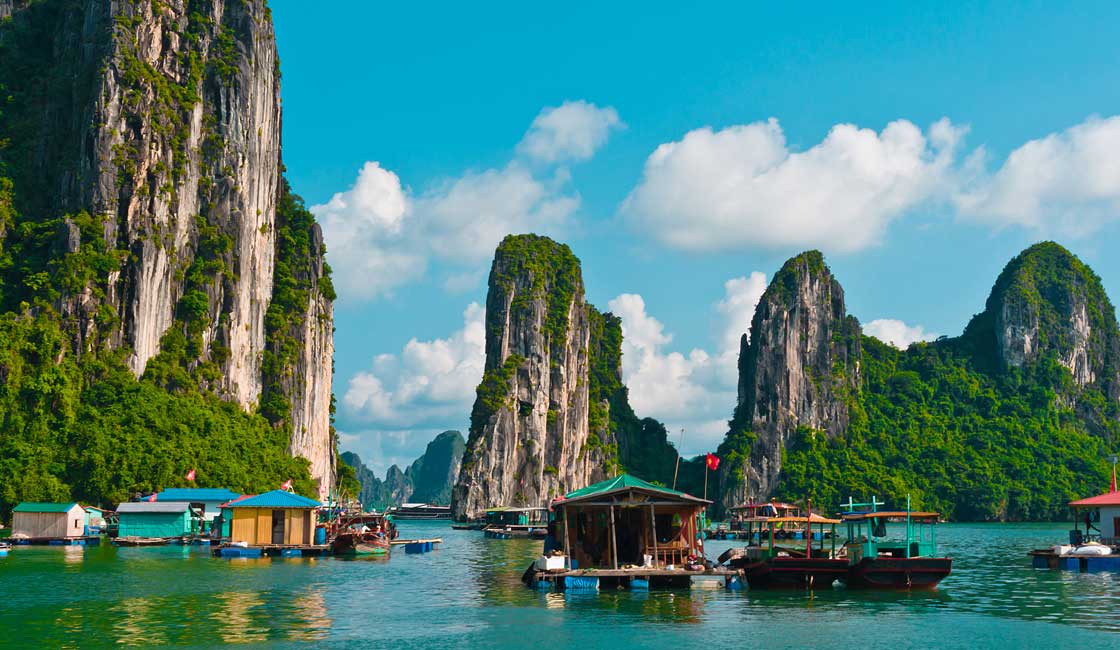
Fish farms in Halong Bay
This vast bay area is not just one of Asia’s most spectacular natural wonders, protected as a World Heritage Site, but one big tourist attraction in itself and one of Vietnam’s most iconic sights. Northern Vietnam’s stuff of legends, this ‘Bay of Descending Dragons’ presents an ethereal seascape of 2,000-plus limestone islands and rock formations magically jutting out of the Gulf of Tonkin’s emerald-hued waters. Halong Bay’s southern extension, the extraordinarily beautiful Lan Ha Bay, reveals equally stunning scenery, but as a relatively new tourism destination with fewer tourist vessels passing through, offers a more remote, tranquil experience.
Both Halong and Lan Ha bays are prime cruising territory, especially the overnight luxury varieties, viewing an ever-changing backdrop of jungle-clad karsts from the sundeck and a fantastical playground for nature and adventure activities. Explore mythical caves and floating fish farms, kayak to hidden lagoons, and snorkel off coral beaches, while the bay’s largest island, Cat Ba, offers trekking, mountain biking, and rock climbing opportunities for amongst primeval rainforests. For the ultimate birds-eye view, take a stupendous seaplane scenic flight over the entire bay.

Spectacular site in Ninh Binh Province
In northern Ninh Binh Province, Tràng An Scenic Landscape Complex is uniquely a World Heritage Site for both its nature and culture, spellbinding visitors with its spectacular landscapes of timeless waterways and jungle-covered limestone karsts and towering cliffs dramatically rising from jade-green valleys, along with ancient sites of great national significance.
The big drawcard is taking a paddleboat through two main tourist attractions, in this watery wonderland, dubbed a ‘land-locked Halong Bay and ‘outdoor geological museum.’ At Tam Coc, enjoy a slow, languorous sampan ride along the tranquil Ngo Dong River, which merges with lush rice paddies surrounded by surreal limestone formations and gliding underneath three low-hanging grottoes. At Trang An, an equally impressive boat ride transports you along emerald-green waterways brimming with rich biodiversity overshadowed by stunning islets and a series of karst caves and caverns which the boat passes through. Off the boats, be sure to visit magnificent Bái Đính Pagoda, Vietnam’s largest Buddhist pagoda complex and the ancient capital of Hoa Lu, where two dynastic temples stand at the site of 10th and 11th-century citadel.
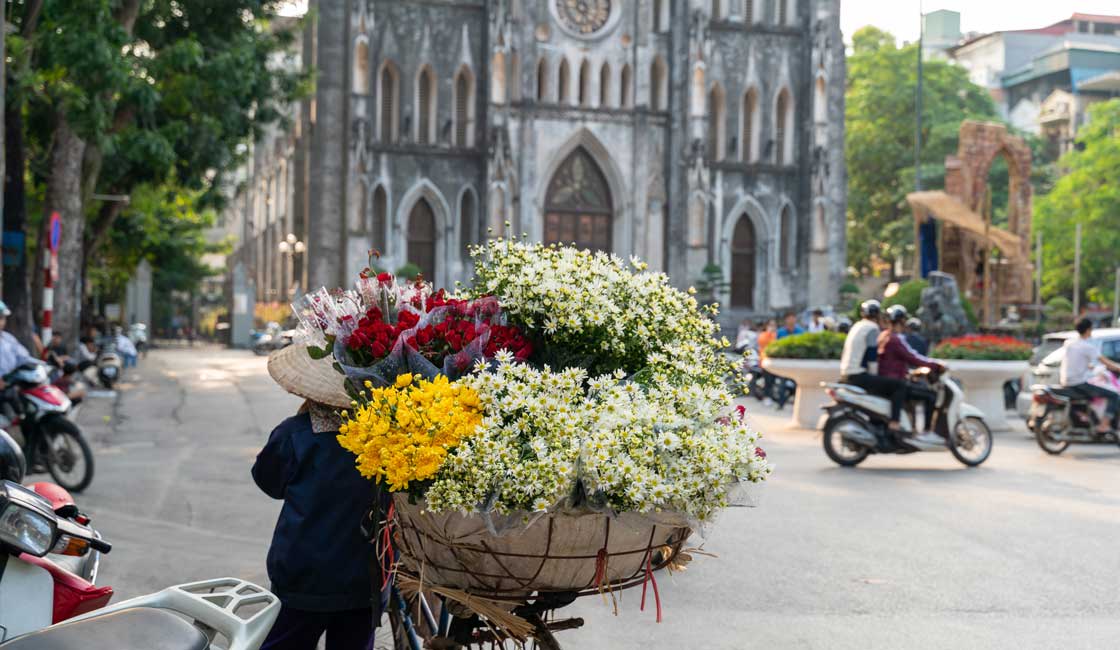
Flower vendors are always present in the Old Quarter
Nestled beside the Red River, Vietnam’s enchanting ancient capital, Hanoi, is jam-packed with wonderful things to see. Key attractions and centuries-old legacies are clustered in clearly defined historic districts, with the most popular being the evocative Old Quarter, a compact, a square kilometer of ancient merchant quarters, dating back more than 500 years – something not to miss on your vacation in Vietnam.
Since the 15th century, each street specialized in specific craft merchandise of which it was named after; even today, some of these charming streets still specialize in that original product or the modern equivalent, from tombstones to silk.
Take a stroll or cyclo ride through this endearingly chaotic quarter, a fascinating glance at Hanoi’s daily life played out on the streets and soak up key sights that include merchant ‘tube houses’ and 11th century White Horse Temple. Be sure to stop-off at one of the gorgeous artsy cafés and street food eateries.
Just south is Hoan Kiem Lake, an unexpected oasis of tranquility and beauty at the heart – literally – of Hanoi, awarded ‘Special National Relic’ status. Translating as ‘Lake of the Restored Sword,’ legend-strewn Hoan Kiem is hugely popular with locals and tourists at any time. However, come at sunrise, when Hanoians flock here to exercise on the lake’s shaded shores and on weekend evenings when the surrounding streets morph as a vibrant pedestrianized zone with open-air entertainment.
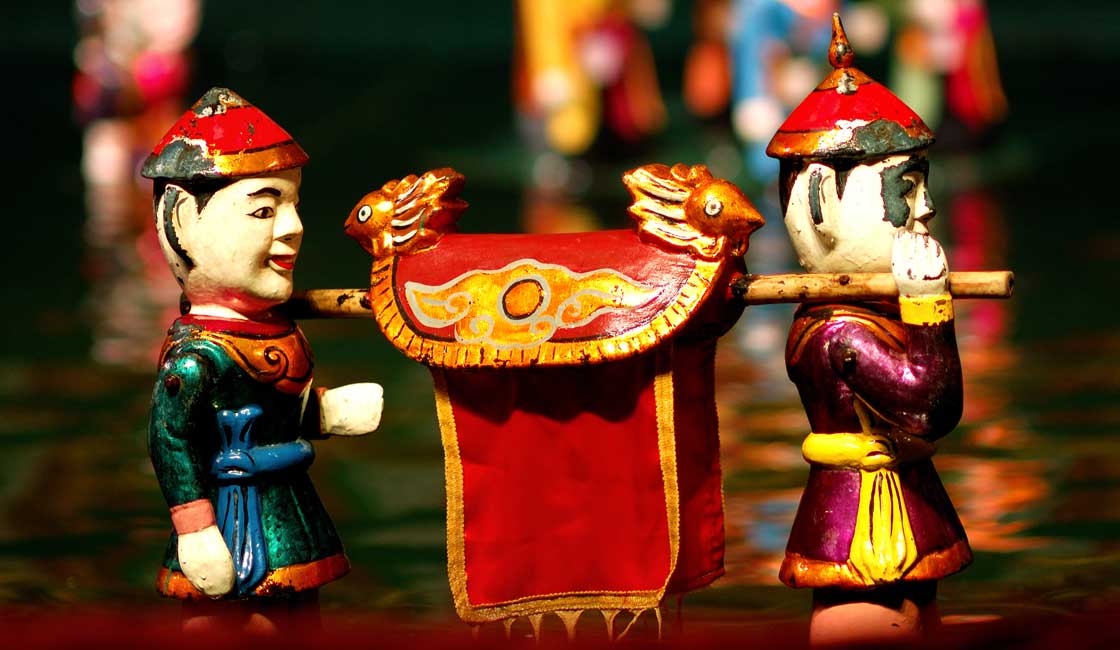
Hanoi is the best place to watch the performance
You don’t have to be a child to enjoy Vietnam’s enchanting water puppetry; deep insight into traditional folklore and a surprisingly quirky, cultural experience.
Traditional water puppetry originated in the North’s Red River Delta, where for centuries, farmers practiced this recreational art form in flooded paddies. Handed down the generations, this unique puppetry nearly died out but has seen a huge revival, recognized as an Intangible Cultural Heritage and performed in theatres in major cities and award-winning international tours.
Hidden behind a bamboo screen, puppeteers manipulate lacquered wooden puppets using rods while wading in waist-deep water, which act out traditional stories based on ancient folk tales and rural village life on an ever-changing, watery stage, The hour-long shows of short vignettes are accompanied by live traditional music and while all in Vietnamese, the comical, delightful puppetry and music keeps the audience enthralled. In Hanoi, book your tickets at the world-famous Thang Long Water Puppet Theater and in Ho Chi Minh City, at The Golden Dragon Water Puppetry Theater or Museum of Vietnamese History.
While Rainforest Cruises aim to provide accurate and up-to-date information, we make no representations as to the accuracy or completeness of any information herein or found by following any link on this site. Rainforest Cruises cannot and will not accept responsibility for any omissions or inaccuracies, or for any consequences arising therefrom, including any losses, injuries, or damages resulting from the display or use of this information.




